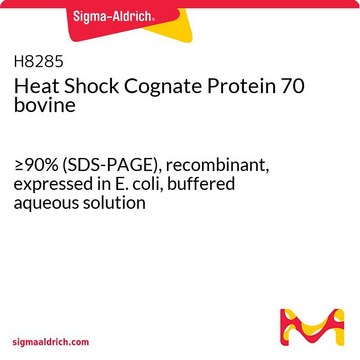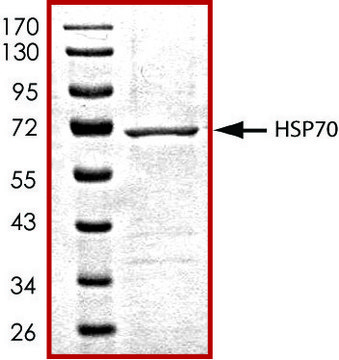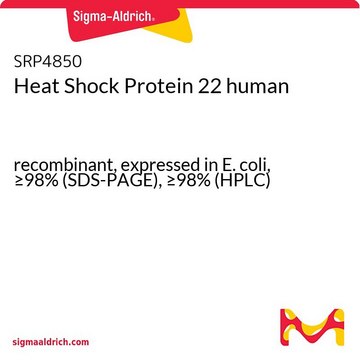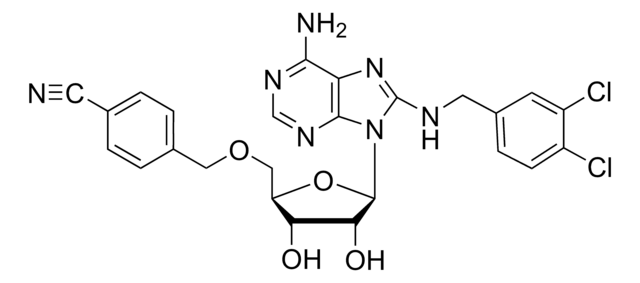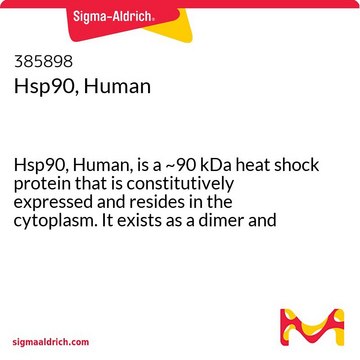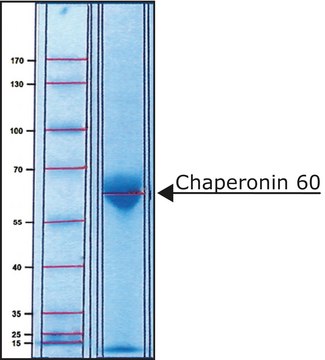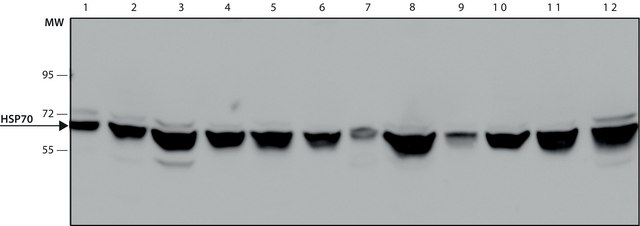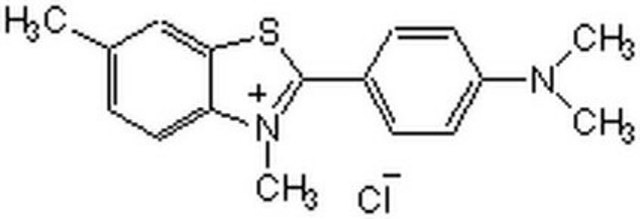H7283
Heat Shock Protein 70 human
recombinant, expressed in E. coli, buffered aqueous solution, ≥90% (SDS-PAGE)
Synonym(s):
HSP 70
Sign Into View Organizational & Contract Pricing
All Photos(1)
About This Item
UNSPSC Code:
12352202
NACRES:
NA.32
Recommended Products
biological source
human
Quality Level
recombinant
expressed in E. coli
Assay
≥90% (SDS-PAGE)
form
buffered aqueous solution
UniProt accession no.
shipped in
dry ice
storage temp.
−70°C
Gene Information
human ... HSPA8(3312)
Application
Heat shock protein 70 human has been used as a control for checking antibody reactivity.
Biochem/physiol Actions
HSPA8 (heat shock 70kDa protein 8) is a human cytoplasmic chaperone which is involved in protein folding, protein aggregation prevention and protein transport. During nutrient stress, it participates in antigen transport to regulate MHC (major histocompatibility) class II presentation. It is upregulated in cancer cells and is involved in protein homeostasis, leading to cancer cell growth and survival.
Physical form
Solution in 2.7 mM KCl, 1.5 mM KH2PO4, 137 mM NaCl, and 8.1 mM Na2HPO4.
Storage Class Code
10 - Combustible liquids
WGK
WGK 1
Flash Point(F)
Not applicable
Flash Point(C)
Not applicable
Regulatory Information
常规特殊物品
Choose from one of the most recent versions:
Already Own This Product?
Find documentation for the products that you have recently purchased in the Document Library.
Huaqun Zhang et al.
Structure (London, England : 1993), 23(3), 472-482 (2015-02-17)
The ubiquitin ligase CHIP plays an important role in cytosolic protein quality control by ubiquitinating proteins chaperoned by Hsp70/Hsc70 and Hsp90, thereby targeting such substrate proteins for degradation. We present a 2.91 Å resolution structure of the tetratricopeptide repeat (TPR)
Sarah N Deffit et al.
Molecular immunology, 68(2 Pt A), 85-88 (2015-05-09)
Cells rely on multiple intracellular trafficking pathways to capture antigens for proteolysis. The resulting peptides bind to MHC class II molecules to promote CD4(+) T cell recognition. Endocytosis enhances the capture of extracellular and cell surface bound antigens for processing
Bing Zhou et al.
Journal of virology, 82(14), 6962-6971 (2008-05-02)
Severe acute respiratory syndrome coronavirus (SARS-CoV) is the etiological agent of SARS, an emerging disease characterized by atypical pneumonia. Using a yeast two-hybrid screen with the nucleocapsid (N) protein of SARS-CoV as a bait, the C terminus (amino acids 251
Masako Tanaka et al.
PloS one, 9(5), e96785-e96785 (2014-05-08)
Heat shock cognate protein 70 (Hsc70) acts as a molecular chaperone for the maintenance of intracellular proteins, which allows cancer cells to survive under proteotoxic stress. We attempted to use Hsc70 to identify key molecules in cancer cell survival. Here
Nor Afiqah Aleng et al.
PloS one, 10(8), e0135603-e0135603 (2015-08-20)
Mild heat stress promotes thermotolerance and protection against several different stresses in aquatic animals, consequences correlated with the accumulation of heat shock protein 70 (Hsp70). The purpose of this study was to determine if non-lethal heat shock (NLHS) of the
Our team of scientists has experience in all areas of research including Life Science, Material Science, Chemical Synthesis, Chromatography, Analytical and many others.
Contact Technical Service